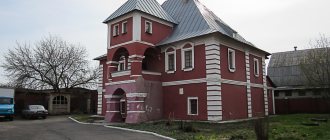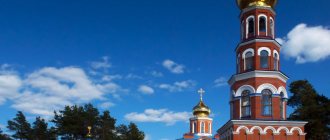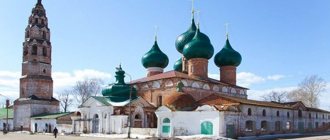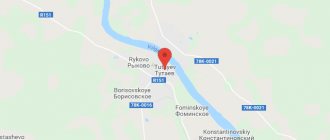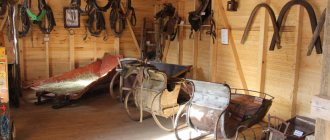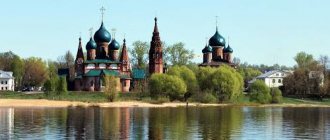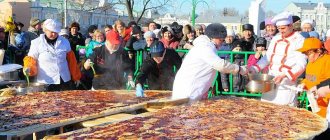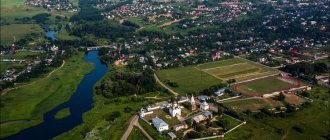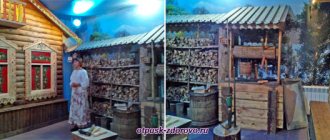The Yaroslavl region is famous throughout the world for its beautiful churches, architectural monuments, ancient history and natural sites. Of the 8 cities of the Golden Ring, 3 are located in the Yaroslavl region - Yaroslavl, Pereslavl-Zalessky and Rostov the Great.
The history of the Yaroslavl region is rich in significant events and historical monuments: it was in Uglich in 1591 that a tragedy occurred that radically changed the course of Russian history - the heir to the throne, the son of Ivan IV the Terrible, young Tsarevich Dmitry, died, as a result of which the Romanov dynasty came to power. In 1612, during the occupation of Moscow by the Poles and Lithuanians, Yaroslavl became the temporary military capital of Rus', here Minin gathered the first militia.
Content:
- Ancient Russian cities of the Yaroslavl region Yaroslavl
- Pereslavl-Zalessky
- Rostov Veliky
- Uglich
- Rostov Boris and Gleb Monastery
Holy Vvedensky Tolga Convent
Not far from Yaroslavl there is a convent, which is the oldest Orthodox monastery. It was built during the Mongol-Tatar yoke, when Russian people sought protection from their enslavers.
The Tolga Monastery was badly damaged during a fire at the end of the 14th century. For a long time it was believed that the icon of the Mother of God, which was fundamental in the monastery, burned down. But miraculously she was discovered in a neighboring village. In honor of such a miraculous resurrection, the residents erected a chapel.
0%
The temple was restored from stone by order of Tsar Ivan the Terrible in the mid-16th century. Where the iconographic image of the Savior Not Made by Hands is kept to this day.
Address: Yaroslavl, Tolga village, 1
Coordinates: 57.696700, 39.827393
Website: montolga.ru
Monastery on the map
Ancient Russian cities of the Yaroslavl region
The Yaroslavl region is home to 1.254 million people, more than 81% are urban. In addition to the regional center, there are several other cities in the Yaroslavl region that are included in the popular routes of the “Golden Ring” of Russia. The oldest of them are Rostov Veliky, Pereslavl-Zalessky, Uglich, Rybinsk, Myshkin, Tutaev, Danilov, Gavrilov Yam and Lyubim.
Yaroslavl
Article: Yaroslavl – the capital of the “Golden Ring” of Russia
Church of Elijah the Prophet in Yaroslavl
Travelers are attracted by the more than thousand-year history of the ancient Russian city. Yaroslavl is considered the first Christian settlement created on the Volga. The regional center is home to 606 thousand people and there are 800 cultural and historical monuments.
Tourists come to Yaroslavl to look at the beautiful, well-equipped Volga embankment, the picturesque ancient churches of John the Baptist and Elijah the Prophet, the Metropolitan Chambers and the Tolga St. Vvedensky Monastery. Many guests definitely stop by the historical and art museum-reserve.
Pereslavl-Zalessky
Article: Pereslavl-Zalessky – the city of ancient legends
Spaso-Preobrazhensky Cathedral in Pereslavl-Zalessky
Ancient Pereslavl-Zalessky is one of the most visited places in the Golden Ring. The first mention of the city dates back to 907. Grand Duke Alexander Nevsky was born and lived here, and the ships of the famous “amusing” flotilla were built at the shipyards on the shore of Lake Pleshcheevo in Peter’s time.
Tourists travel to Pereslavl-Zalessky for the beautiful architectural ensembles of ancient monasteries - Goritsky, Nikolsky, Fedorovsky, Holy Trinity Danilov and Nikitsky. In the center of the city, on Red Square, the ancient Spaso-Preobrazhensky Cathedral, erected at the beginning of the 12th century, is preserved - the same age as Pereslavl itself. This temple is famous as the baptism site of Alexander Nevsky.
Rostov Veliky
Article: Rostov the Great - bell ringing and enamel
View of the main entrance to the Rostov Kremlin
The small town, where 30 thousand people live today, played a huge role in the history of our country. Rostov is considered the birthplace of the famous enamel and the oldest city in Russia - it appeared in 862. The flow of tourists wanting to see the majestic Kremlin on the shores of Lake Nero does not stop either in summer or winter.
Many pilgrims come to the ancient city who seek to touch the Christian shrines of Spaso-Yakovlevsky
,
Abraham
and
Nativity
monasteries, and admire the graceful forms
of the Church of Isidore the Blessed on the Ramparts
.
In Rostov there is an almost rebuilt Varnitsky Holy Trinity Sergius Monastery
, which was founded in the 15th century.
Uglich
Article: Sights of Uglich - pages of the history of the Russian city
View of the Uglich Kremlin
The small Volga city is known as the place where the difficult Time of Troubles for Russia began. In 1591, eight-year-old Tsarevich Dmitry, heir to the Moscow throne, died here. According to one version, the boy was killed by order of Boris Godunov.
In Uglich you can look at the monuments of ancient Russian architecture - the Temple of Tsarevich Dimitri on the Spilled Blood
, built at the end of the 17th century, the chambers of local appanage princes, the Epiphany Cathedral and
the Church of the Transfiguration
. Every year, on May 28, the day of the death of the prince in Uglich, the festive ten-day period “Blagostina” begins. During it, concerts, competitions and meetings with famous people are held.
Church of Demetrius on the Spilled Blood
Church of Demetrius on the Spilled Blood. Uglich, Yaroslavl region. Photo: Victoria Demidova / photobank “Lori”
On May 25, 1591, the youngest son of Tsar Ivan IV the Terrible, Tsarevich Dimitri, died in Uglich. According to one version, he was killed, and according to another, the prince himself ran into a knife while playing with him. Already in 1606, Dmitry Uglitsky was canonized. At the site of his death, first a wooden chapel was built, and in 1630 a wooden temple. Another 50 years later a stone church was founded here. The princes of Cherkassy, relatives of the deceased prince on his mother’s side, donated money for it. Moscow architects built the building in the style of Russian patterning: the façade of the church was decorated with cornices, stucco moldings and platbands. The temple was specially painted red - according to the architects' idea, it symbolized the blood of the prince.
At the end of the 18th century, icon painter Pyotr Khlebnikov painted the temple. Together with his students, he created frescoes on the themes of the biblical tales “On the Creation of the World” and “The Fall of Adam and Eve and Their Expulsion from Paradise,” as well as the death of Dmitry Uglitsky. After the revolution, a museum exhibition was placed here - this saved the church from looting. In the 1970s, the frescoes inside the temple were restored and strengthened in the Church of Demetrius on the Spilled Blood. Today the church is part of the Uglich State Historical, Architectural and Art Museum.
Author: Anastasia Voiko
Sights of the Yaroslavl region
Rostov Boris and Gleb Monastery
Article: Rostov Boris and Gleb Monastery - a famous monastery on the way from Rostov to Uglich
General view of the Rostov Boris and Gleb Monastery
The history of the founding of the men's monastery in the village of Borisoglebsky is connected with Sergius of Radonezh. In 1363, an ascetic of the Russian Orthodox Church came to pacify the local princes who were warring among themselves and met here the hermit monks Fyodor and Paul.
At first the monastery was built of wood, and then it took on the appearance of a real powerful fortress. According to legend, the legendary Peresvet took monastic vows outside the monastery walls. In 1924, the monastery was closed, but 70 years later it was returned to believers.
Lake Nero
Article: Lake Nero - the birthplace of Rostov-Suzdal Russia
View of the Rostov Kremlin from Lake Nero
In the middle of the industrial-agrarian landscapes of the Yaroslavl region there is a picturesque reservoir, which is shrouded in secrets and legends. On the shores of Lake Nero, the Rostov-Suzdal principality arose, which lies at the heart of ancient Rus'. The natural oasis has a large area - 51.7 square meters. km, but with a small depth - up to 3.6 m. According to scientists, the age of the lake has exceeded 500 thousand years. The first tribes began to live on its banks about 6,000 years ago.
This is evidenced by the remains of ancient ceramics and tools made of stone and bone. Legends about the ancient Kitezh city, which, according to ancient chronicles, stood on the Yaroslavl lands in the 12th-13th centuries, are associated with Nero. True, no archaeological finds have been made to confirm this assumption.
Church of St. John the Evangelist on Ishna
Article: Church of St. John the Evangelist on Ishna - a monument to the skill of Rostov carpenters of the 17th century
View of the Church of St. John the Evangelist on Ishna
The high temple near the village of Ishna in the Rostov region turned 335 (2021) years old. This is surprising because the ancient church is built of wood.
The unique monument to Rostov carpenters looks like a fairy-tale palace. The decor of the wooden church has many chopped and carved elements, which is why artists have always loved to depict it.
The tiered temple stands on a high basement. It is believed that previously the spacious cellars were used for storerooms and for storing local treasury. The wooden quadrangle and the refectory have extensions or “divisions”. At the very top there is a dome and a drum with a plowshare onion dome with a cross.
Lake Pleshcheyevo
Article: Lake Pleshcheyevo – the pearl of Zalesye
Kitesurfing and windsurfing on Lake Pleshcheyevo
Near the city of Pereslavl-Zalessky there is a reservoir, which is called one of the best decorations of the “Golden Ring”. The large round lake measures 9.5 by 6.5 km, and its depth reaches 25 m. Lake Pleshcheyevo arose during the Ice Age and is located at an altitude of 170 m above sea level. 19 rivers and streams flow into the reservoir, the largest of which is the Trubezh River, and only one river flows out - Veksa.
Pilgrims come to the lake to get water from the famous Varvarin spring and relax on Alexander Mountain. History buffs are interested in the ancient earthworks that remained after the medieval city of Kleshchino.
View of the Nikitsky Monastery and Lake Pleshcheyevo
There are many interesting museums in the surrounding villages, where you can see the wooden boat of Peter I
, old gramophone records,
teapots
,
locomotives, carriages
, collections of coins and banknotes. Fans of outdoor activities love the Yaroslavl reservoir for its excellent opportunities for fishing, windsurfing and kitesurfing.
Blue stone
Article: Blue stone - a legend on the shore of Lake Pleshcheyevo
One of the most famous sights of Lake Pleshcheyevo is a huge boulder weighing about 12 tons. The legendary Blue Stone is about 3 m long. It was brought to the shore of the lake during the Ice Age. Now the large boulder has practically grown into the ground and rises above it by only 30 cm.
View of the Blue Stone
The stone is called blue because it is composed of fine-grained quartz biotite schist. In the light of the sun, quartz grains play against the background of biotite flakes, creating a bluish glow effect.
The most popular legend says that the stone “moves” on its own. The wonderful legend was not born out of nowhere. Over its long history, the shoreline of Lake Pleshcheevo has changed several times. Once upon a time, the boulder lay at the bottom, and then “unexpectedly” found itself near the water’s edge.
Chapel of the Cross near Pereslavl-Zalessky
Article: Chapel of the Cross - memory of the birth of the king's son
View of Chapel Cross
At the entrance to Pereslavl-Zalessky from Moscow there is a beautiful tented chapel dedicated to the Great Martyr Fyodor Stratelates. The Chapel of the Cross was erected in the 17th century on the site where Tsarevich Fedor, the youngest son of Tsar Ivan the Terrible, the last representative of the Rurik family, was born.
Fedor ascended the throne after his father and ruled Russia from 1584 to 1598. The stone chapel, which has survived to this day, was erected instead of a wooden building. The monument of Russian architecture looks like a squat open tent on columns and is decorated with elegant brick ornaments.
Rostov Kremlin
View of the Rostov Kremlin. Rostov Veliky, Yaroslavl region. Photo: Litvyak Igor / photobank “Lori”
The Kremlin in Rostov the Great is the former residence of the bishops of the Rostov-Yaroslavl diocese. It began to be built in the 1650s by order of Metropolitan Jonah III Sysoevich. For his residence, he chose a place in the city center, next to the stone Assumption Cathedral of the 16th century.
Architect Pyotr Dosaev built for the Metropolitan a utility building, the building of the Judgment Order, the White and Red Chambers, the Church of the Savior on Senya and St. John the Evangelist. Next to the Assumption Cathedral, according to the architect’s plan, a belfry was erected, for which 13 bells were cast. Each of them had its own tonality. The largest bell, weighing about 32 tons, was named Sysoy - in honor of the metropolitan.
In the 1680s, all buildings were surrounded by stone walls with towers. Since the fortress did not serve a defensive function, the walls were decorated with stucco, and wide windows with platbands were placed on the towers next to the loopholes.
New buildings on the territory of the Kremlin appeared by decree of the successor of Jonah Sysoevich, Metropolitan Joasaph. In 1693, the Church of Hodegetria was built here in the Moscow Baroque style. Its facade was decorated with special relief masonry, which was called “diamond rustication”. Later, the department of the metropolitan of the Rostov-Yaroslavl diocese was moved to Yaroslavl, and services in the churches of the Rostov Kremlin ceased, and the premises began to be used as warehouses. In the 19th century, the buildings became dilapidated, and they even wanted to demolish them. But on the initiative of Rostov patrons of the arts, the Kremlin was preserved and restored.
The buildings of the complex were heavily damaged during Soviet times. In 1953, some of them were destroyed by a tornado that passed through the Yaroslavl lands. The Kremlin was restored in the 1960s. The films “Ivan Vasilyevich Changes His Profession”, “Boris Godunov”, “My Affectionate and Tender Beast” were filmed in the recreated interiors.
In 1991, the Assumption Cathedral and belfry were transferred to the Russian Orthodox Church, and services began there again. The remaining buildings of the complex house exhibitions of the Rostov Kremlin Museum-Reserve.
Estates of the Yaroslavl region
Ganshin Estate Museum
But not only cities make up the historical heritage of the Yaroslavl region. On its territory, many ancient villages and estates have been preserved, associated with various pages of Russian history and the names of its famous citizens.
Near Pereslavl-Zalessky there is the Ganshin estate-museum, which tells about the history of peasant life. The Museum of Wooden Architecture in Myshkin is also dedicated to traditional rural Russian architecture. Here you can visit residential buildings, a bathhouse, look into the chapel and the village blacksmith. And in the Nekrasovsky district of the region, in the village of Profintern, it is worth looking at the palace of the Ponizovsky merchants, built in a fusion of eclectic and modernist styles at the beginning of the last century.
Memorial House-Museum of N. A. Morozov
An interesting story is connected with the former owner of the estate in the village of Borok - scientist Nikolai Aleksandrovich Morozov. The house and garden that belonged to him can still be visited today. ON THE. Morozov was called by his contemporaries the Russian Count of Monte Cristo. In his youth he was associated with the Narodnaya Volya movement and was convicted for this. During his imprisonment in Petropavlovskaya
and
Shlisselburg
fortresses, this versatile scientist wrote 26 volumes of research in the fields of physics, astronomy, mathematics, linguistics and aeronautics.
Museum-estate "Karabikha"
15 km south of Yaroslavl, in the Karabikha estate, there is a memorial house-museum of the great Russian poet Nikolai Alekseevich Nekrasov. Here, on Yaroslavl soil, he created the poems “Frost - Red Nose”, “Russian Women” and “Who Lives Well in Rus'”. Every year on July 7, the All-Russian Nekrasov Poetry Festival takes place in Karabikha.
In the village of Rybnitsa, it is worth visiting the house-museum of the famous sculptor Alexander Mikhailovich Opekushin (1838-1923). Monuments to M.Yu. made by the hands of this master. Lermontov and A.S. Pushkin has been known to every Russian since childhood.
Museums of the Yaroslavl region
In the Museum “Music and Time” in Yaroslavl
There are more than 250 museums in the region, the exhibitions of which reflect the thousand-year history of the Yaroslavl lands. In the city of Pereslavl-Zalessky alone there are about 20 museum collections.
Among Yaroslavl museums, the “Music and Time” museum, created in the regional center in 1993, is noteworthy.
It became the first private museum in the post-Soviet space. In a small mansion on the Volzhskaya embankment, sonorous bells, ancient music boxes and organs, gramophones and gramophone records, a variety of musical instruments, icons and old clocks are exhibited.
Exhibition at the Finifti Museum in the Rostov Kremlin
Several museums are also open in the Rostov Kremlin. And the most visited of them is, perhaps, the museum of enamel. It contains a rich collection of beautiful enamel miniatures - real works of art. Museums of a mouse, a workhorse, steam locomotives, a coachman, gramophone records, radios, antique sewing machines - you name it in the Yaroslavl region!
The most beautiful places in Yaroslavl
Review of the city's brightest sights.
Yaroslavl is an ancient city with an interesting and rich history, imprinted on the streets and various architectural landmarks. A curious eye will see many ancient monuments scattered throughout the center. This review will tell you about the most beautiful places in Yaroslavl.
Arrow
The Yaroslavl "Strelka", the confluence of two rivers, was restored in 2010, for the thousand-year anniversary of the city. Colorful musical fountains, lawns, a landscape park, the banks of the Volga - a wonderful place for a walk and relaxation. There is a view of Kotorosl and the Volga, and if you turn around, you will see the recently erected Assumption Cathedral. The Metropolitan Chambers, the Arsenal Tower are the starting point of the ensemble of churches throughout the center of Yaroslavl. Yaroslav the Wise began construction of the city at Strelka. The ancient image of the place was even recreated in the historical feature film “Yaroslav. A thousand years ago."
Volzhskaya embankment
Volzhskaya embankment is a favorite vacation spot for city residents. A flat path along the right bank of the Volga descends from Lenin Avenue to Strelka. For the thousand-year anniversary of the city, the embankment was reconstructed, a third level was added to it, very close to the waves of the river. Moving along the river, you can see the monument to Nekrasov, and a little further away the Nekrasov gazebo is a popular place for photography. Across the road you will find the “Music and Time” museum, and closer to the “Strelka” you will meet the art museum, the Arsenal, the metropolitan chambers on the territory of Rubleny Gorod, and a smooth turn of the path will lead you to the confluence of two rivers - the Volga and Kotorosl, above which rises the majestic Assumption Cathedral.
Tolga Monastery
The Tolgsky convent is considered one of the most beautiful places in Yaroslavl. The history of the monastery is very interesting in many respects, for example, a walk through this place will be very exciting for those who are interested in the history of the Orthodox religion, the history of Russian architecture, and for those who are passionate about the art of icon painting. The monastery is located eight kilometers from the city border, standing on the left bank of the Volga River. For centuries, an atmosphere has been created here, which is alien to worldly problems and everyday worries. Many Yaroslavl artists, musicians and actors come to Tolga for inspiration. The monastery is active, but the doors are open to anyone who wants to come inside.
Tveritskaya embankment
Tveritskaya embankment is located in the Zavolzhsky district of the city. Adjacent directly to the largest and cleanest sandy beach in Yaroslavl. During the swimming season this is a very busy place. In winter, spring and autumn it is a place for romantic walks. The so-called Tveritskaya Sloboda is located on the low bank of the Volga. The appearance of pre-revolutionary Yaroslavl can be seen in the silhouettes of the streets located directly next to the Tveritskaya embankment. And if you walk to the very end, you will find yourself on the site of the most ancient human settlement of the Neolithic era.
Tugova Gora
The name of this place comes from the word “to push” or “tuga”. A long time ago, here, in a desperate battle with the Mongols, many Yaroslavl residents were killed. In memory of the terrible event, a church was built on the mountain, and many famous Yaroslavl residents were buried in the quiet Tugovogorsk cemetery. Here in July, Tugovaya Mountain Day is celebrated annually. It's a very peaceful place. From Tugovaya Mountain there is an unusual view of the central part of the city.
The chopped city, or the Yaroslavl Kremlin
The chopped city in Yaroslavl is the name of the place where, as legend tells, the city was founded. Today there are no reminders of this. The appearance of this place has changed many times. With each new era came new changes. But one thing has remained the same since time immemorial: the magnificent panorama of the Volga River. Many periods of Yaroslavl's history are reflected in monuments and buildings. This is where the Yaroslavl Eternal Flame is located. The beautiful architecture of ancient buildings, an abundance of greenery and an embankment with benches make this place very romantic, sincere and memorable.
Zemlyanoy city
Almost 500 years ago there was a fire in the city and Yaroslavl burned out completely. Elena Glinskaya, the famous mother of Ivan IV, ordered the city to be rebuilt. An earthen rampart was built on the northwestern side, and part of the city inside it was named Zemlyanoy. You can get to the territory of the former Zemlyanoy Gorod directly from the Volzhskaya embankment - by going down into the Medveditsky ravine, crossing the stadium and going out onto the Kotoroslnaya embankment, which will lead you to the far border of Zemlyanoy Gorod - the Spassky Monastery. From all the buildings of the ancient place, only three towers remain today - Znamenskaya, Arsenalnaya and Uglichskaya.
Millennium Park
If you walk along Kotoroslaya embankment, you will not be able to pass by the Millennium Park. It is located near the river bank and was built in honor of the millennium of Yaroslavl. A long time ago, there was a hippodrome on this site, and now there are trees, in the planting of which cosmonaut Valentina Tereshkova participated. Zurab Tsereteli donated the controversial cast-iron bear to the park. If you have children with you, they will have a place to play in the spacious playgrounds with a safe surface.
Island-park "Damansky"
"Damansky" is the largest family amusement park in Yaroslavl. Located in the central region, in the waters of the Kotorosl River. This advantage has allowed Damansky to become a favorite place for recreation and entertainment for city residents of all ages. But everyone who comes to visit Yaroslavl is recommended to visit “Damansky”, because everyone loves to have fun, and most importantly, to relax culturally and have a good time in their free time! A large selection of attractions, summer cafes where ice cream is prepared for children and barbecue for adults, will make the Damansky Island Park an excellent option for your weekend getaway.
If you know other most beautiful places in Yaroslavl, please share in the comments.
Natural monuments of the Yaroslavl region
The flat territories of the Yaroslavl region occupy 36.17 thousand square meters. km. Slightly less than half of them are covered with mixed forests. To protect pristine nature and species diversity in this region, several protected areas have been created: the Darwin Nature Reserve, the Pleshcheyevo Lake National Park and 45 state reserves. In addition, in the Yaroslavl region, 321 objects have been declared a natural monument.
View of Lake Pleshcheyevo from Alexandrova Mountain
The “Yaroslavl” reserve was organized on the shore of the Kostroma reservoir. Here you can find more than 40 protected species of fauna, including beaver, muskrat and white-tailed eagle. The Verkhnevolzhsky forest reserve was created to preserve the southern taiga biocenosis. Brown bears, wolves, foxes, raccoon dogs, lynxes and other mammals typical of Central Russian forests live here. An interesting natural monument created by human hands is the dendrological garden named after. S.F. Kharitonov in Pereslavl-Zalessky
. It contains a rich collection of plants from all continents on an area of about 60 hectares.
In the dendrological garden named after. S.F. Kharitonov, on the “Trail of Fairy Tales”
Many travelers come to this ancient Russian city specifically to see the picturesque Lake Pleshcheyevo. It attracts fishermen, windsurfers, lovers of antiquities, as well as those who want to touch the legendary Blue Stone, which has been lying since time immemorial on the lake shore near Alexander Mountain. And in mid-July, on the shores of Lake Pleshcheevo, the annual hot-air balloon festival “Golden Ring of Russia” takes place.
All news
It may flood again: which streets of Yaroslavl will go under water during a severe flood. List
Pressed for the main thing: a Yaroslavl resident’s iPhone was seized for dozens of traffic police fines
“We had to force them to work”: the Ministry of Emergency Situations filed complaints against the actions of the authorities during the flood
The environmental prosecutor's office found those responsible for river floods in the Yaroslavl region
They released the water blindly: why Yaroslavl was flooded and who will be responsible for the destruction
“It could have been prevented”: the governor decided to find the culprit of the winter flood in the Yaroslavl region
“The situation is critical”: in Yaroslavl, car depot employees are freezing at work
Auto: Updated Hyundai Solaris revealed before the premiere: mesh grille and huge multimedia screen
The weather in Yaroslavl will deteriorate sharply: the Ministry of Emergency Situations has announced an emergency warning
Auto: The long-awaited ŠKODA KAROQ will be presented to Yaroslavl residents in February
Shops appeared from under the ice: photo report from the flooded embankment in Yaroslavl
The Ministry of Emergency Situations named the cause of the flood in Yaroslavl
In the Yaroslavl region, a fisherman survived after sitting in the forest for two days in the cold
“Be understanding”: in Yaroslavl the authorities refused to clean the roofs of houses from icicles and snow
“Church expediency”: The Yaroslavl diocese gave the scandalous cemetery to the city
“In different poses in one room”: Yaroslavl residents were offered to rent silicone girls
Deferment instead of payment: MKB launched a convenient tool for business in the CIS countries
Heat, showers and hurricanes: weather forecasters gave a monthly weather forecast for summer 2020
Yaroslavl City Hall may demand compensation for damage due to flooding
That's "Parasite"! Let's see who won the Oscar this year
“Smart” electricity metering devices were appreciated by residents of 405 apartment buildings in the Yaroslavl region
Auto: Analysis group: a frightening overtaking ended in a head-on impact - we find out what went wrong
Two boats carrying tourists from Russia collided in Thailand. Two children died
What kind of healthy lifestyle person are you? 10 questions about weight loss mistakes
“It’s easier to move to another area”: in Yaroslavl, the exit from Bragino will be blocked by road repairs
“You’ll get sworn at for your bare shoulders”: 13 facts about South Korea from a Yaroslavl traveler
Get used to the anomalies: warming is coming to Yaroslavl. And this will last for a long time
Kirkorov, DiCaprio and Banderas: who is the odd one out at the Oscars and who was awarded the main film awards
“Not sick? Then let it stand.” A mother and child were not given a seat on a minibus: the reaction of social networks
“They made Chikatilo out of a son”: the mother of a Yaroslavl resident who killed a guy near a shopping center was harassed over the phone
Cystitis and prostatitis due to fashion. Why is it better not to roll up your jeans in winter?
“Furniture [end], floor too”: a Yaroslavl resident filmed a house destroyed by a flood
Three insights after childbirth: why I condemned young mothers
A mother who ran away from two children demanded maternity capital
Mrs. Yaroslavl - 2022: look at photos of the most luxurious married ladies
Even children shouldn’t eat it: nutritionists tell us what’s hidden in your favorite porridge
“Save”: revelations from a father who spent a whole year on maternity leave and changed his mind about women
Raised and burned: how work changes people’s hands
“This is despair”: in Yaroslavl, a grandmother sprinkled salt on the icy sidewalk. Video
Where to go with children in the Yaroslavl region
In the Yaroslavl Museum of Grandfather Mazai
In the regional center - Yaroslavl, the Grandfather Mazai Museum, the private Favorite Bear Museum, the Einstein Museum of Entertaining Sciences, the Planetarium, the Zoo and the Children's Railway are open for children.
In Pereslavl-Zalessky with children, you should definitely check out the local teapot and
iron
, the interactive museum-workshop “Nakhodka” and the museum of cunning and ingenuity. In addition, at the beginning of June, the colorful festival “Visiting Berendey” is held annually in Pereslavl-Zalessky.
Not far from this ancient city in the village of Vasilevo there is a museum “The Birth of a Fairy Tale”, where children can meet the heroes of their favorite Russian fairy tales, made by the hands of the talented artist A. Tikhonov. The Uglich Museum of Myths and Superstitions can also boast of a similar exhibition. Its author, artist Daria Chuzhaya, made life-size images of fairy-tale characters.
Museum of Teapots in Pereslavl-Zalessky
In Myshkin, children really like the tourist complex - the carved palace “Myshkiny Chambers” and the museum of felt boots, in Rostov - the entertaining museum “The Frog Princess”, and in Poshekhonye - the museum “Toptygin House”.
The annual Yaroslavl festivals and holidays are of great interest for traveling with children. Almost all of them take place in the warm season. On July 18, it’s worth coming to Tutaev to take part in the festival “Romanov’s Sheep – the Golden Fleece of Russia.” And at the end of July, two interesting holidays take place at once. In Pereslavl-Zalessky, historical clubs gather for the festival “There will be a Russian Navy!”, and in Myshkin there is a festival of retro equipment “Myshkinsky Samokhod”.
Museum "The Frog Princess" in Rostov the Great
At the beginning of August, a wonderful tourist holiday “Visiting the Ryaba Chicken” is organized in the village of Ermakovo, Rybinsk region. And at the end of August you can come to Rostov the Great for the tourist holiday “Alyosha Popovich - Rostov Hero”.
Almost every city in the Yaroslavl region has interesting attractions and museums for children. In most of them, the organizers invite young guests to plunge deeper into the secrets of ancient crafts and conduct interesting master classes for children in pottery, wood painting, making birch bark jewelry, souvenirs and dolls.
Tourist complex "Myshkin Chambers" in Myshkin
What to bring as a souvenir
Traditional souvenirs that people try to buy in the Yaroslavl region are linen products, handmade black-polished ceramics, excellent “Kuznetsov” porcelain, elegant Pereslavl embroidery and enamel jewelry.
You can bring practical sheepskin products from Tutaev. From Yaroslavl - ringing bells, which became popular back in the days when craftsmen began working in the city, casting bells for churches.
Spaso-Preobrazhensky Cathedral in Rybinsk
Among the “delicious souvenirs,” the most popular items are Rostov kvass, Poshekhon and Uglich cheeses, Yaroslavl beer, “Old Kashin” balsam, and Pereslavl smoked vendace. A good time for shopping is the beginning of autumn - the traditional time of agricultural fairs. At the beginning of September, an elegant merchant fair is held in Rybinsk and on the Volzhskaya embankment of the city. On these same days, the annual gastronomic festival “Lukova Yarmonka” takes place in Rostov.
| ← RUSSIA | EUROPE → |
Church of John the Baptist
The famous temple was built in 1687 in the city of Yaroslavl. It was rebuilt by the local residents themselves. The nine tiers of the church preserve the memory of biblical stories.
This is the largest and most famous church in the city. Fifteen chapters adorn the ancient building. Like many churches, the Church of John the Baptist suffered a fire in the mid-17th century. And a new building was already being erected in the suburb of Tolchkovskaya Sloboda.
During the Soviet period of our country, within the walls of the temple there was first a temperance society, then a library. A little later, the publishing house of the magazine “Parish Life” was established.
And after the Great Patriotic War, the Forerunner parish was formed, thanks to whose efforts a church was rebuilt with the style characteristic of those times.
Address: 2nd Zakotoroslnaya embankment, 69, Yaroslavl
Coordinates: 57.610888, 39.856975
Church of John the Baptist on the map
